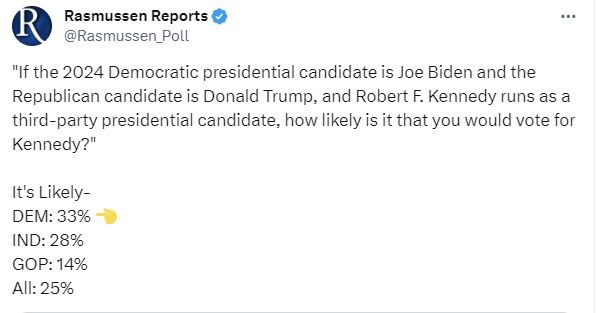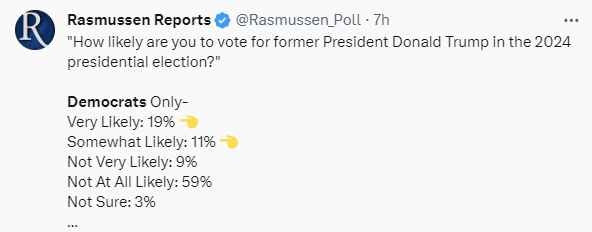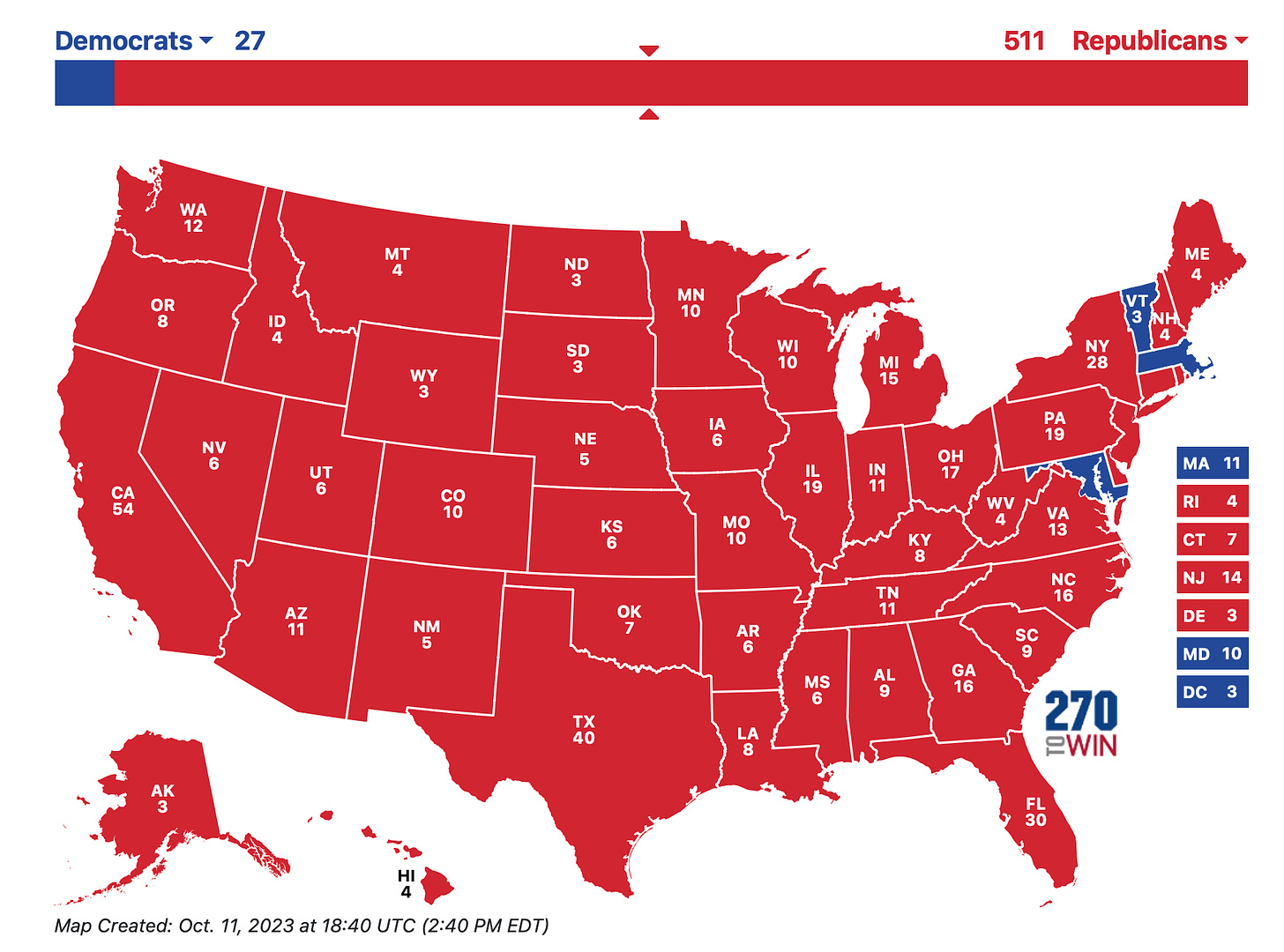Polling is a tool, and nothing more. If polls were constantly unbiased and accurate, there would be neither need for elections nor debate for new legislation on the floors of the various state capitols. Polling can be weaponized in order to suppress the vote, or, more relevant to present times, to justify final outcomes of fraudulent elections.
See, we knew all along it would be down to the wire, and after nine days of counting ballots, the Democrat won by an eyelash, just like we predicted – that’s why the Washington Post is considered an A+ pollster!
Polling is still an important task when done for the right reasons. If you’re running for Senate in Arizona, it is good to know where your message is sinking in, and where it is missing the mark. That will dictate how much time, energy, money, and other campaign resources are sunk into the areas that need to be fortified. If polling numbers show a higher than usual level of support in the only significant Democrat stronghold in the state, Pima County, then it gives the signal to go for the kill and run up the score in the rural Republican areas. In contrast, weak numbers there and in other GOP strongholds tell that candidate to focus on the beast, Maricopa County, where more than 60% of the state’s voters reside.
I am, above all things, a strategist. My job as an Army intelligence officer was to advise my commander on all things intelligence – enemy strength and composition, friendly capabilities and constraints, terrain and weather analysis, and all sorts of wonky details all the way down to moon illumination. All of these things compose the end product known as intelligence preparation of the battlefield (IPB). Most battalion-level planning sessions include a most likely enemy course of action (MLCOA) and a most dangerous course of action (MDCOA). Failure to plan is planning to fail.
That is why, when I write pieces about how I believe the entrance of Robert F. Kennedy, Jr., into the presidential race is a good thing, and that Kennedy himself is the man who makes the case against himself better than anyone else, my readership above all should understand that I am making these predictions with a starting point grounded in basic political strategy and potentially winnable elections. No battle plan survives first contact with the enemy, and an effective military strategist first assesses the conventional planning for a mission before throwing in the inevitable curveballs that are spun once a unit crosses the line of departure.
Of course I account for election fraud. I am one of the founding fathers of what the usual mainstream media detractors refer to as the election denialism movement. I’m even thought of as an election denial “leader,” which is strange to me given that most Americans agree with me – I’m not some fringe rebel. Nevertheless, people should know damn well that I expect the 2024 election to be one of the dirtiest events in the history of humankind, and not only for the event itself, but for the entire run-up to the election, beginning at literally any time now, to be marred with one manufactured crisis after another.
Therefore, please take all further dot-connecting, forecasting, poll-reading, commentary, candidate quote interpretations, party chicanery decodings, and any other musings related to political analysis regarding the 2024 quasi-election considering the paragraphs above – namely that I don’t expect a clean election to go down in one year’s time.
With that out of the way, I will now demonstrate to you exactly why the political establishment knows it is doomed to another Trump term if they fail to remove him from the ballot or otherwise arrive at a way to sideline him and render him incapable of being elected.
I. Experiment Boundaries
For the sake of the experiment, I will use the bloated certified total of ballots from the 2020 quasi-election, which stands at 158.4 million.
Joe Biden had 81.3 million certified ballots. Donald Trump had 74.2 million. Other candidates combined for roughly 2.9 million.
In any given election, about 8% of a party’s membership will vote for the candidate of the other party. That will be impacted further by Kennedy’s inclusion in the race, but because the general crossover is similar, I will consider it baked into the proverbial cake.
II. Gallup Gold Standard of Party Affiliation
32 states register voters by party, but those numbers can be inconclusive or even inaccurate. Gallup has long gaged party affiliation, which in recent years shows a very high share of independent voters, which lean 49%-43% in favor of Republicans according to their most recent estimate. While self-identifying Democrats outpaced Republicans 31%-30% at the time of the 2020 quasi-election, that number is now 28%-24% in favor of Republicans.
Therefore:
158.4 million ballots
28% Republican = 44.4 million ballots
24% Democrat = 38.0 million ballots
46% Independent = 76.0 million ballots
III. Damning Recent Partisan Polling
Rasmussen threw some bombs this week. They will be the first to admit that state race polling is difficult thanks to many factors, including polling methodology, but they are very accurate when it comes to polling issues, such as the impact of a powerful third-party candidate.
Rasmussen reported 33% of Democrats would be likely to vote for Kennedy, along with 28% of independents. Most importantly, just 14% of Republicans would be likely to do so, which is only about 6% more than the percentage of party defectors in any given presidential election.
To further complicate Biden’s re-election, 19% of Democrats are very likely to vote for Donald Trump, with another 11% somewhat likely. For sake of this exercise, I will estimate on the side of caution and managing expectations, and will deduct only the very likely defectors to Trump (I would personally estimate Trump defectors to Biden at less than 1%).
If all partisan affiliations were expected to vote for their party’s nominee, and 2020 ballot totals remain static, here is a revised tally:
Biden
38.0 million Democrats
Less
12.5 million (33% of Democrats vote for Kennedy, 38.0 million x .33)
Less
7.2 million (19% of Democrats vote for Trump, 38.0 million x .19)
Total
18.3 million
-
Trump
44.4 million Republicans
Less
6.2 million (14% of Republicans vote for Kennedy, 44.4 million x .14)
Plus
7.2 million (19% of Democrats vote for Trump, 38.0 million x .19)
45.4 million
-
Kennedy
Plus
12.5 million (33% of Democrats vote for Kennedy, 38.0 million x .33)
Plus
6.2 million (14% of Republicans vote for Kennedy, 44.4 million x .14)
18.7 million
IV. Breaking Out Independents
Now, let’s break out the stubborn and irritating independent vote, which Gallup has leaning 49-43 Republican. These numbers will still be conservative, because I’ve seen polling showing Trump up double-digits over Biden with non-partisans.
I have accounted for the roughly 82.4 million partisan votes in the previous section, which has Trump leading Biden by 27.1 million and Kennedy, who is incredibly in second place, by 26.7 million.
There are 76 million more votes to assign nationally.
Kennedy, at 28% of the independent vote, gets 21.3 million more votes (76.0 million x .28), bringing his total to 40.0 million, or 25.3%, edging out H. Ross Perot’s 18.9% share from 1992, which will likely win him some counties and get him close to being the first third-party candidate to win electoral votes since 1968, most likely in states like Hawaii, Maine, Washington, or Oregon.
Between Trump and Biden, that leaves roughly 54.7 million votes. If those go to Trump by six points and I split them 54-46%, Trump gains another 29.5 million (54.7 million x .54), and Biden picks up 25.2 million (54.7 million x .46).
Final division of 158.4 million ballots:
Trump
74.9 million
(47.2%)
-
Biden
43.5 million
(27.5%)
-
Kennedy
40.0 million
(25.3%)
Conclusion
By now, you should know why Newsweek wrote a panic piece about a RFK candidacy a week before the news broke. If Rasmussen is correct that a disparate number of partisan defectors comes from the Democrat, not Republican, camp, as I have surmised, and that 19% of Democrats are likely to vote for Trump (and it could be much worse if that number is the rumored 30%), then Trump wins by tens of millions of votes, and would produce a map like this:
We are a long way out. My only advice to you is to expect not only what is expected, which is one manufactured crisis after another, but also to expect things you’ve previously thought impossible to be rolled out to thwart the greatest threat the political class has seen in modern times.
Do I expect everything to go off just like I’ve laid out? No. But I believe in justice and irony, and when they go together, they make an amazing, satisfactory tune and a comprise a story for the ages. Turnabout is fair play, and I can think of no greater comeuppance than for those who defrauded our nation to step into snares of their own design. Now you know why the professional political ruling class is so desperate to install someone, anyone, else.








This is very encouraging. But I don’t think for a second anyone of us should back off on reforming our elections at the county level.
I just saw these poll numbers last night, and was running the same rough calculations in my head... Thank you for your always detailed and insightful analysis!